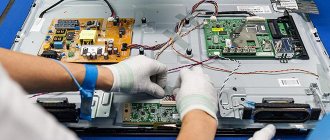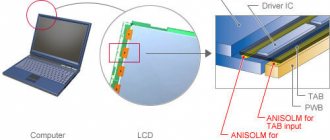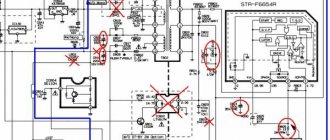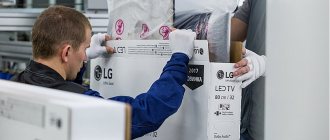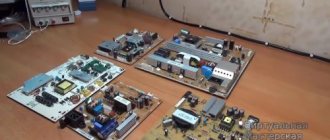Seal
Burnt inverter keys
For a good image on an LCD TV, the matrix must have good lighting. In LCD TVs, the backlight is provided by a voltage inverter made using lamps, LEDs, or more advanced OLED (organic light-emitting diode-based) backlighting. The backlight should provide uniform illumination of the entire surface of the matrix, sufficient brightness, and a quick response to changes in signal brightness.
The most common sign of a faulty inverter is the absence of a picture when there is sound. Although another option is possible, when the TV tries to turn on, but goes into standby mode again and the sound does not appear.
It is impossible to describe all possible malfunctions of inverters, so in this article I will give the main ones, by understanding the essence of which you will be able to repair LCD TV voltage inverters with your own hands.
Here are some signs that the inverter is faulty:
- The backlight does not turn on;
- The backlight turns on and off immediately;
- Does not turn on after a long period of inactivity;
- Screen brightness flashing;
- Uneven screen brightness.
But first, let's look at their structure.
LCD TV inverter board for 4 lamps
INVERTER DEVICE
The inverter device can be divided into functional blocks, from which it becomes clear that they are all similar to each other.
The below circuit diagram of the inverter belongs to the lamp backlight. The lamps are connected using a capacitive circuit, which ensures their constant glow over time and provides effective brightness control. Transistors Q1, Q2 – turn on and turn on the inverter.
Inverter circuit diagram
Block (1) provides constant voltage to a self-oscillator with switches ((4) usually consists of two field-effect transistors, for example APM4010 and APM4015), which is turned on and controlled by PWM signals. The brightness control unit (2) and PWM (3) are usually constructed in one chip. A pulse-width modulator (PWM) controls the load in the secondary circuits and, if the lamps malfunction, does not allow the autogenerator 4 to turn on, which will protect against failure of the keys or transformer.
The required luminous flux is created by cold cathode fluorescent lamps (R) located behind the matrix and uniformly illuminate it.
TV settings are wrong
It happens that the channel settings are lost. The TV memory chip is in no way related to the backlight. In this case, there are ripples on the screen and there is no sound. The TV is slow to show channels, you should check the provider's promotions. Enjoy, www.youtube.com/watch?v=YtqrIVaEDNI#t=11. The video says: without updating the software, Tricolor TV channels will refuse to be received. The problem can be easily resolved by following these steps.
Broadcasting is carried out in the DBV-T2 format - the channels are divided into multiplexes. One frequency transmits many programs; the TV, using the built-in adapter, extracts the information broken up by frames, converting it into a screen-friendly form. The multiplex settings are lost and all the channels included in the set disappear. You need to know the broadcast frequency. Corresponds to the digital television channel number. Then you need to visit the TV menu and start searching for channels on the selected frequency. Upon completion of the operation, a list of detected stations, signal strength, and quality should appear on the screen.
Sometimes the antenna is to blame. In our area, cables are often cut, especially satellite cables. And not at all for the purpose of handing over non-ferrous metals to a collection point, for reasons of competition. The action is very difficult to track and punish. From time to time, local providers try to suppress the “heavenly” ones broadcasting via satellite. It’s trivial to check the quality of the connection. In the event of a break, the receiver will not see the converter or disk.
We hope we answered the question of why the TV doesn’t show, what could be broken, and how to fix the problem. Now readers can find the problem themselves. Please note that the backlight lamps should be removed as carefully as possible to avoid damage.
- alt=”Why the TV won’t turn on” width=”120″ height=”120″ />Why the TV won’t turn on
- alt=”Why the TV doesn’t work” width=”120″ height=”120″ />Why the TV doesn’t work
- alt=”The TV does not show well from the antenna” width=”120″ height=”120″ />The TV does not show well from the antenna
- alt=”Why doesn’t the TV see the hard drive” width=”120″ height=”120″ />Why the TV can’t see the hard drive
Hello! There is a yasin led 32e58ts TV. It turns on, but when turned on it instantly shows a different color and then only a black screen. Doesn't receive any signals. I connected the computer with an HDMI cable - no signal. Please help me figure it out.
PRINCIPLE OF OPERATION
The inverter must provide several functions:
- Change direct voltage into high-voltage alternating voltage;
- Provide brightness adjustment;
- Stabilize the lamp current and regulate it;
- Provide protection against short circuit and overload.
The matrix backlight inverter (for lamps) should provide a voltage of usually 600 volts with a load current of approximately 10 mA and provide a maximum screen brightness of about 250 cd/m2. In this case, the initial output voltage will be about 1600 V, and the protection response time will be from 1 to 1.3 s. For a reliable start, the protection response time is selected 10 times longer than the start time.
When voltage is supplied from the power supply, a signal (usually 3-5 volts) to exit standby mode arrives approximately 2 seconds after turning on the TV from the main board and the backlight inverter enters the operating state.
The TV inverter controller provides a “soft” start when starting the inverter, as well as protection against short circuits and overloads. If the short circuit lasts less than 1 s, the inverter will continue to operate, otherwise it will shut down.
PWM pulses go to a converter, usually made according to a semi-bridge generator circuit with self-excitation and start the DC/DC converter and voltage for the backlight lamps appears on the secondary winding of the inverter transformer.
The small winding performs a feedback function in the TV inverter circuit.
When the lamps are “ignited” at the beginning of operation, the inverter voltage increases to 1600 V, and only then the inverter goes into operating mode. A faulty lamp, a capacitor in the secondary circuit or a short circuit in the secondary winding leads to generation failure.
The inverter voltage of an LCD TV is usually 24 or 48 volts (for a large diagonal). The laptop backlight is usually powered by a power supply voltage of 18 - 19 volts.
HP laptop inverter circuit diagram.
The board of such an inverter is small in size and located at the bottom of the screen. In this case, the controller U2 OZ9938 controls the keys U1 AM4428, contact CN1 goes to the lamp. Power goes through the VIN contacts, minus GND, brightness and power control goes to the DIM and ENA contacts.
Laptop inverter
Autonomous power supply
Of course, advanced connoisseurs of independent alternative energy know that 12 220 inverters are the basis and heart of autonomous power supply systems based on solar panels and wind generators.
But for fans of traditional “internal combustion” technologies who value the reliability and all-weather durability of a 1000-liter fuel oil tank, a rare generator seller will offer to supplement their favorite diesel engine with a “competing” device - a 220 inverter.
In fact, the 220 inverter works great when paired with a generator. The generator and inverter power the house in turn, which reduces fuel consumption by 3-5 times.
The inverter automatically starts the generator to charge the batteries and stops when the batteries are fully charged. The system of an inverter with a generator operates in a constant cyclic mode: power supply to the loads - charge from the generator. Depending on the battery capacity and the average hourly power consumption of loads, the charge-discharge cycle can be once a day or twice. At the same time, the inverter can be configured for periods of “quiet time of day” when the generator’s operation is undesirable. The most typical option is a ban on evening and night hours.
The advantages of combining a generator and an inverter into one autonomous power supply system for a cottage are obvious:
- Most of the day the generator does not work and you can enjoy the silence
- the generator does not have to operate in an abnormal and harmful underload mode (during hours of low power consumption, power comes from the inverter)
- The intervals for tank refilling and generator maintenance are extended.
An additional advantage of inverter systems manufactured by OutBack Power System is the modularity and scalability of an autonomous power supply system with an inverter.
It is not necessary to immediately buy an inverter for the entire power of the cottage , because, unlike a generator (which can only be changed), the power of the OutBack inverter can be increased.
To begin with, you can install a minimal autonomous power supply system and set up operation from the inverter only for lower load hours. The autonomous power supply system can then be expanded. Moreover, you can increase not only the power - with 3 kW inverter modules - but also the autonomy - by connecting solar panels or wind generators to the inverter.
The diagram for the implementation of such a power supply system, combining the complete autonomy of alternative sources with the reliability of a traditional power plant using an internal combustion engine, is shown in the figure below. The only disadvantage of this system is the cost. But independence has never been cheap.
Scheme of autonomous power supply for a cottage
up
REPAIR
Anyone with a little knowledge of electronics and working with a soldering iron and a multimeter can repair the inverter with their own hands, since there is nothing extraordinary about it.
In terms of breakdowns, I can probably say that there are no major ones, everything breaks. Lamps, switches, transformers, controllers burn out.
Most often, the backlight inverter fails due to breakdowns of the electrolytic capacitors in the power supply and the power filters of the inverter itself. Losing capacity, swelling and closing the power circuit, they lower the voltage. The keys begin to work with greater overload and burn out.
In LCD TVs, the diodes themselves burn out more often. When repairing a TV, you can replace the entire LED strip or check each one and replace it individually. For example, your TV has 3 strips of LED strips with 7 diodes on each. It is known that their supply voltage is 70 volts. We divide and get 3.3 volts, look for one with a power of 1 watt to ensure normal brightness and make a replacement.
The models of modern inverters are very diverse, but the principles of their construction and operation are almost the same, and this simplifies their repair.
Possible faults
The most common situation is when the image is displayed on the screen, but there is no backlight. You can only see something on the monitor from a certain angle or by illuminating the display with a bright flashlight.
The reasons for this screen condition may be the following:
- The backlight lamps are in faulty condition. The solution to this problem is very simple - you just need to replace the faulty element and check its functionality. If the required lamp is not available, a resistor with the most suitable power and resistance can be soldered into the circuit.
- The inverter that powers the backlight lamps needs to be repaired.
The second case is more complex, since the circuit of this device contains a large number of elements and each of them can fail. The circuit discussed above contains a high-voltage inverter transformer and many small parts - transistors, resistors, capacitors, etc. In most cases, the fault can be easily identified by the typical black marks left on the board.
During troubleshooting, do not touch the inverter and other electronic boards while the monitor is connected to the network. The greatest danger to life and health is posed by elements under voltage of 1500 V and above.
If the screen backlight is working properly, but there is still no image, you need to check the inverter on the monitor. There are two options to solve this problem:
- The monitor is connected to an external power supply connected to a separate inverter board. Typically, such a malfunction can be eliminated by simply replacing the part and connecting it to the controller board. This is quite possible, since the connectors of most devices are universal.
- In the second case, the monitor has its own built-in power supply, located together with the inverter on a common board. Here, different methods are used to solve the problem, which in most cases can only be done by specialists.




